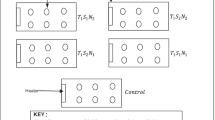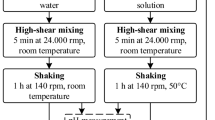Abstract
Red alga Kappaphycus alvarezii Doty is an important commercial species widely cultivated in southeast Asian countries for its polysaccharide, kappa-carrageenan. Common post-harvest handling technique involves sun-drying of harvested seaweed on platforms at the farms. Quantity and quality of carrageenan varies depending on the duration and care taken during the post-harvest handling of the raw seaweed. In this study, dynamics of moisture content, water activity index (aw), carrageenan yield, and carrageenan quality were investigated by subjecting the seaweed to three post-harvest methods: (1) freeze-drying (FD), (2) shade-drying (SD), and (3) direct sun-drying (DSD). Seaweed dried under FD and SD produced high yield (56–58 %), superior gel strength (1,454–1,424 g cm−2), high viscosity (57–58 cPs), and low syneresis (15–17 %). But, carrageenan extracted from DSD seaweed gave 28 % lower yield, 38 % lower gel strength, 27 % lower viscosity, and 8–9 % higher syneresis. In addition, gelling temperature and melting temperature of the DSD carrageenan were lower by 4 and 9 °C, respectively. Molecular size analyses of carrageenan extracted from seaweed dried under FD and SD contained carrageenan of 700 KDa (80 %) and 200 KDa (4–10 %). However, carrageenan extracted from DSD seaweed contained smaller carrageenan molecules, 460 KDa (55 %), 210 KDa (25 %), and <100 KDa (20 %). Further, scanning electron microscope images illustrated the severe effects of DSD on the morphology of seaweed cells. Therefore, SD technique was found to be the best post-harvest processing technique that gave quality carrageenan in a high quantity. Due to its simplicity and low cost, it is a practical approach to be practiced in southeast Asian countries.



Similar content being viewed by others
References
Cordero B, Voltolina D (1997) Viability of mass algal cultures preserved by freezing and freeze-drying. Aquac Eng 16:205–211
FAO (2012) The state of world fisheries and aquaculture 2012. FAO, Rome, p 209
Ferreira D, Lopes da Silva JA, Pinto G, Santos C, Delgadillo I, Coimbra MA (2008) Effect of sun-drying on microstructure and texture of S. Bartolomeu pears (Pyruscommunis L.). Eur Food Res Technol 226:1545–1552
Gardner RG, Mitchell TJ (1956) A study of seaweed drying. In: Braarud T, Sorensen NA. (eds) 2nd Int. Seaweed Symposium. Pergamon Press, London pp 63–79
Gupta S, Cox S, Abu-Ghannam N (2011) Effect of different drying temperatures on the moisture and phytochemical constituents of edible Irish brown seaweed. Food Sci Technol 44:1266–1272
Hayashi L, Hurtado AQ, Msuya FE, Bleicher-Lhonneur G, Critchley AT (2010) A review of Kappaphycus farming: prospects and constraints. In: Israel A, Einav R (eds) Seaweeds and their role in globally changing environments. Cellular origin, Life in extreme habitats and astrobiology, vol 15. Springer, Dordrecht, pp 251–283
Indegaard M, Ostgaard K (1991) Polysaccharides for food and pharmaceutical uses. In: Guiry MD, Blunden G (eds) Seaweed resources in Europe: uses and potential. Wiley, Chichester, pp 169–183
Ireland CT, Mondaca RL, Galvez AV, Lopez J, Scala KD (2011) Influence of hot-air temperature on drying kinetics functional properties, colour, phycobiliproteins, antioxidant capacity, texture and agar yield of alga Gracilaria chilensis. Food Sci Technol 44:2112–2118
McHugh DJ (2003) A guide to seaweed industry. FAO Fisheries Technical Paper No 441. pp 105
Molard DR, Lesage L, Chagnier B (1985) Effect of water activity on mould growth and mycotoxin production. In: Simatos D, Multon JL (eds) Properties of water in foods. Martinus Nijhoff, Netherlands, pp 273–292
Tobacman JK (2001) Review of harmful gastrointestinal effects of carrageenan in animal experiments. Environ Health Perspect 109:983–994
Troller AJ, Christian JHB (1978) Water activity and food. Academic, New York, p 235
Tsuru S (1973) Preservation of marine and fresh water algae by means of freezing and freeze-drying. Cryobiology 10:445–452
US FDA (2013) Generally Recognized as Safe (GRAS). Code of Federal Regulation. 21CFR172.620
Vairappan CS (2006) Seasonal occurrences of epiphytic algae on the commercially cultivated red alga Kappaphycus alvarezii (Solieriaceae, Gigartinales, Rhodophyta). J Appl Phycol 18:611–617
Vairappan CS, Kawasaki M (2008) Nutritional properties, antioxidant potential and antibacterial activity of two edible seaweeds, Kappaphycus alvarezii and Eucheuma denticulatum (Gigartinales, Rhodophyta). Malays J Sci 27:53–65
Vairappan CS, Suzuki M (2000) Dynamics of total surface bacteria and bacterial species counts during dessication in the Malaysian sea lettuce, Ulva reticulata (Ulvales, Chlorophyta). Phycol Res 48:55–61
Vairappan CS, Tan KH, Rossnitta R (2003) Seasonal fluctuations in carrageenan yield in Eucheuma spinosum (Eucheuma denticulatum) cultured in coastal areas of Pulau Balambangan, Kudat, Sabah. Borneo Sci 14:55–61
Webber V, Carvalho SM, Ogliari PJ, Hayashi L, Barreto PLM (2012) Optimization of the extraction of carrageenan from Kappaphycus alvarezii using response surface methodology. Cienc Tecnol Ailment 32:812–818
Werner A, Clarke D, Kraan S (2004) Strategic review of the feasibility of seaweed aquaculture in Ireland. NDP Marine RTDI Desk Study Series, Marine Institute
Zobell CE, Upham HC (1944) A list of marine bacteria including descriptions of sixty new species. Bull Scripps Inst Oceanogr 5:239–292
Author information
Authors and Affiliations
Corresponding author
Rights and permissions
About this article
Cite this article
Vairappan, C.S., Razalie, R., Elias, U.M. et al. Effects of improved post-harvest handling on the chemical constituents and quality of carrageenan in red alga, Kappaphycus alvarezii Doty. J Appl Phycol 26, 909–916 (2014). https://doi.org/10.1007/s10811-013-0117-1
Received:
Revised:
Accepted:
Published:
Issue Date:
DOI: https://doi.org/10.1007/s10811-013-0117-1




